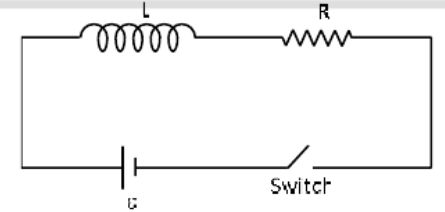A simple LR circuit is connected to a battery at time t=0. The energy stored in the inductor reaches half its maximum value at time
RL In [√2√2−1]
LR In [√2−1√2]
LR In [√2√2−1]
RL In [√2−1√2]
The correct Answer is:C
To solve the problem of finding the time at which the energy stored in an inductor reaches half its maximum value in an LR circuit, we can follow these steps:
1. Understanding the Maximum Energy Stored in the Inductor:
The maximum energy stored in an inductor Umax is given by the formula:
Umax=12LI20
where I0 is the steady-state current when t→∞.
2. Current in the LR Circuit:
The current I(t) in an LR circuit connected to a battery is given by:
I(t)=VR(1−e−RLt)
where V is the voltage of the battery and R is the resistance.
3. Finding the Current When Energy is Half Maximum:
We want to find the time t when the energy stored in the inductor is half of its maximum value:
U(t)=12LI(t)2=12Umax=14LI20
Setting I(t)=VR when t→∞, we have:
I0=VR
Thus, we need:
12LI(t)2=14L(VR)2
4. Substituting for I(t):
Substitute I(t) into the equation:
12L(VR(1−e−RLt))2=14L(VR)2
5. Simplifying the Equation:
Cancel 12L from both sides:
(VR(1−e−RLt))2=12(VR)2
Taking square roots:
VR(1−e−RLt)=VR√2
Cancel VR (assuming V≠0):
1−e−RLt=1√2
6. Solving for e−RLt:
Rearranging gives:
e−RLt=1−1√2
7. Taking the Natural Logarithm:
Taking the natural logarithm:
−RLt=ln(1−1√2)
Thus, solving for t:
t=−LRln(1−1√2)
8. Using the Identity:
We can simplify 1−1√2 as √2−1√2:
t=−LRln(√2−1√2)
This can be rewritten using logarithmic properties:
t=LR(ln(√2−1)−ln(√2))
9. Final Expression:
This leads us to the final expression:
t=LRln(√2√2−1)
Which matches with the options provided.
Conclusion:
After comparing with the options, we find that the correct answer is:
t=LRln(√2√2−1)
The maximum energy stored in an inductor Umax is given by the formula:
Umax=12LI20
where I0 is the steady-state current when t→∞.
The current I(t) in an LR circuit connected to a battery is given by:
I(t)=VR(1−e−RLt)
where V is the voltage of the battery and R is the resistance.
We want to find the time t when the energy stored in the inductor is half of its maximum value:
U(t)=12LI(t)2=12Umax=14LI20
Setting I(t)=VR when t→∞, we have:
I0=VR
Thus, we need:
12LI(t)2=14L(VR)2
Substitute I(t) into the equation:
12L(VR(1−e−RLt))2=14L(VR)2
Cancel 12L from both sides:
(VR(1−e−RLt))2=12(VR)2
Taking square roots:
VR(1−e−RLt)=VR√2
Cancel VR (assuming V≠0):
1−e−RLt=1√2
Rearranging gives:
e−RLt=1−1√2
Taking the natural logarithm:
−RLt=ln(1−1√2)
Thus, solving for t:
t=−LRln(1−1√2)
We can simplify 1−1√2 as √2−1√2:
t=−LRln(√2−1√2)
This can be rewritten using logarithmic properties:
t=LR(ln(√2−1)−ln(√2))
This leads us to the final expression:
t=LRln(√2√2−1)
Which matches with the options provided.
After comparing with the options, we find that the correct answer is:
t=LRln(√2√2−1)
Topper's Solved these Questions
- BOOK - CENGAGE PHYSICS ENGLISHCHAPTER - INDUCTANCEEXERCISE - Exercises (multiple Correct )7videos
INDUCTANCE
- BOOK - CENGAGE PHYSICS ENGLISHCHAPTER - INDUCTANCEEXERCISE - Exercises (assertion-reasoning)2videos
INDUCTANCE
- BOOK - CENGAGE PHYSICS ENGLISHCHAPTER - INDUCTANCEEXERCISE - Exercises (subjective)7videos
INDUCTANCE
- BOOK - CENGAGE PHYSICS ENGLISHCHAPTER - HEATING EFFECT OF CURRENTEXERCISE - Thermal Power in Resistance Connected in Circuit27videos
HEATING EFFECT OF CURRENT
- BOOK - CENGAGE PHYSICS ENGLISHCHAPTER - MAGNETIC FIELD AND MAGNETIC FORCESEXERCISE - Multiple Correct Answer type2videos
MAGNETIC FIELD AND MAGNETIC FORCES
Similar Questions
In an LR circuit connected to a battery, the rate at which energy is stored in the inductor is plotted against time during the growth of current in the circuit. Which of the following best represents the resulting curve?
View SolutionThe circuit is switched on at t=0, Find the time when energy stored in inductor becomes 1n tiimes of maximum energy stored in it:
 View Solution
View SolutionThe circuit is switched on at t=0, Find the time when energy stored in inductor becomes 1n tiimes of maximum energy stored in it:
 View Solution
View SolutionA 35.0V battery with negligible internal resistance, a 50.0Ω resistor, and a 1.25mH inductor with negligible resistance are all connected in series with an open switch. The switch is suddenly closed
(a) How long after closing the switch will the current through the inductor reach one-half of its maximum value?
(b) How long after closing the switch will the energy stored in the inductor reach one-half of its maximum value?View SolutionA coil having an inductance L and a resistance R is connected to a battery of emfε. Find the time elapsed before, the magnetic field energy stored in the circuit reaches half its maximum value.
View SolutionIn a decaying L−R circuit, the time after which energy stores in the inductor reduces to one fourth of its initial values is
View SolutionAn L−C circuit consists of an inductor with L=0.0900H and a capacitor of C=4x10−4F. The initial charge on the capacitor is 5.00μC, and the initial current in the inductor is zero.
(a) What is the maximum voltage across the capacitor?
(b) What is the maximum current in the inductor?
(c) What is the maximum energy stored in the inductor?
(d) When the current in the inductor has half its maximum value, what is the charge on the capacitor and what is the energy stored in the inductor?View SolutionHow many time constants will elapse before the energy stored in the capacitor reaches half of its equilibrium value in a charging RC circuit ?
View SolutionHow many time constants will elapse before the energy stored in the capacitor reaches half of its equilibrium value in a charging RC circuit ?
View SolutionLet C be the capacitance of a capacitor discharging through a resistor R. Suppose t1 is the time taken for the energy stored in the capacitor to reduce to half its initial value and t2 is the time taken for the charge to reduce to one-fourth its initial value. Then the ratio t1/t2 will be
View Solution

